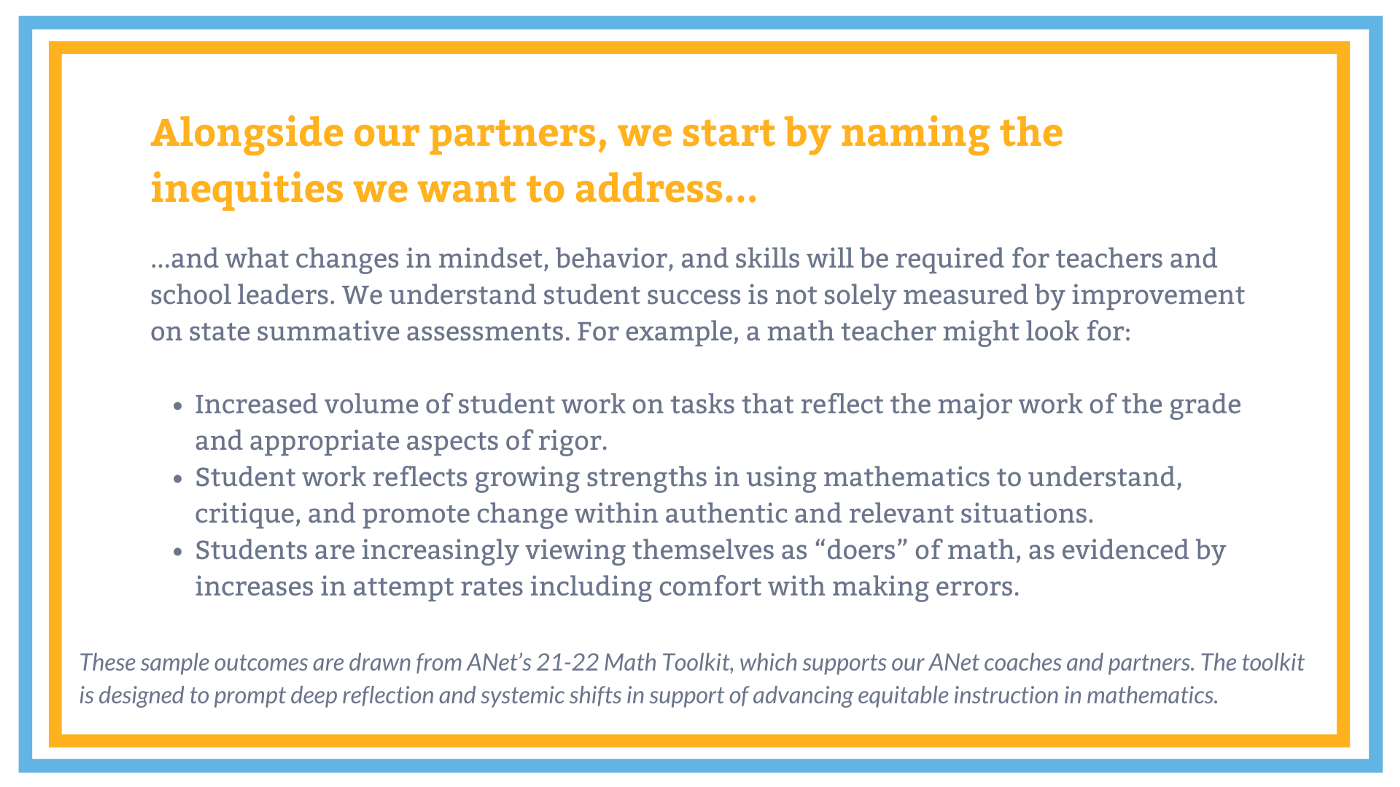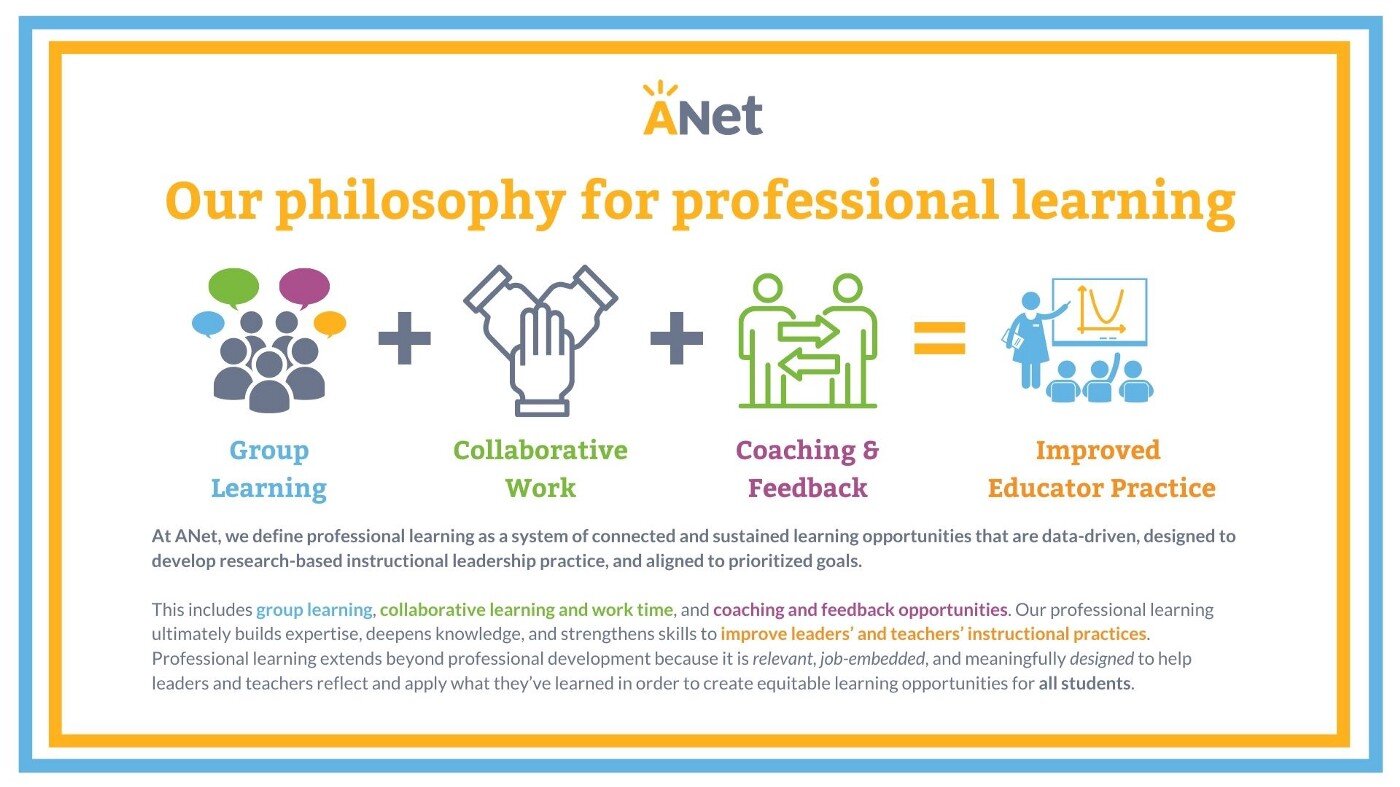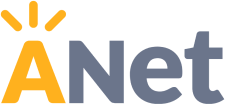America’s schools and districts have an unprecedented opportunity to invest in our students and their futures. For the past fifteen years, ANet has worked alongside school, district, and state-level leadership teams to strengthen core instruction and achieve breakthrough results for students. We have seen what works. We deeply believe that coherence within any education ecosystem is key. Today’s K-12 federal funding creates a once-in-a-lifetime opportunity for districts and schools to create more equitable learning experiences for all students. But without careful planning principles, we might look back in a few years having made no real tangible impact in the lives of the students we serve — or worse yet — inadvertently see the result of this stimulus further exacerbating long-standing inequities.
Below, we outline our five guiding principles for education leaders as they plan to invest ESSER funds:
1. Listen
Key Question: Whose voices are you listening to?
Students have always been at the heart of education. For many years, however, the system has failed in its promise to teach all students well, and it has failed to hear, see, and design complete learning experiences that honor students’ unique perspectives and experiences. If we know that one size does not fit all, then we must do more to tailor to our communities’ needs. And as we faced the twin pandemics of this past year, we all have had to confront the compounding impact of that reality. Heading into this next year, it is incumbent on leaders and educators at all levels to earnestly consider how they are elevating, listening to, and taking action in response to the voices of the students and communities they serve. We aim to listen intently and also create the cultures, practices, and leadership that, together, lead to increased student learning, engagement and sense of belonging.
Through our anti-racism and culture team’s partnerships with the Ferguson-Florissant School District in Missouri, we set up system leadership teams to be “lead listeners.” We created and trained a community-based Change Team, with student voice playing a central role. Members of the Change Team range from students and parents, to the Chief of Police and community and board members. Our work to bolster equity literacy skills is intended to improve student learning, engagement and sense of belonging. Our training was inclusive of all stakeholders within the district including food services, transportation, custodial staff, teachers, district leaders, and community members — all leading to the deeper impact of changing the students’ experience and modeling our anti-oppression principle: To make change, the perspectives and lived experiences of people from marginalized populations must be brought to the center of discourse and taking concrete actions based on what is heard must be prioritized.
2. Commit to coherence
Key Question: Do the priorities or themes of your plan point coherently toward equitable instruction?
In this moment of opportunity and optimism about the next phase of education, there is also a real risk. Historically, our school systems have been flooded with new programs and initiatives — ideas that each claim to be a silver bullet but result in fatigue and student outcomes that are no better than when we started.
If everything is a priority, then nothing is. We must meet this moment with a relentless eye toward coherence that enables equitable instruction. We must put time, energy, and resources to ensure that the pieces of our strategy fit together and that they center on students and the instruction they are offered each day.
We know — and have seen to be true — that creating coherence across high-quality materials, instruction, assessment strategy, and professional learning leads to more equitable instruction for students.

3. Expand the definition of great instruction
Key Question: Does instruction for your students include the what, the who, and the how?
For the past year, many of our partners and those in the education space have been consumed by the idea of “learning loss”, urgently seeking ways to meet the needs of students impacted by school closures and interrupted teaching and learning. We too easily got swept up in the worry over the impact of lost instructional time and what that would mean for student learning. But this way of thinking is rooted in deficit and fear and can lead to over-remediation and denial of opportunities for grade-level content.
Our charge as educators is to think beyond just what we teach and to continue to reimagine and explore the intersection of who we teach and how we teach. Our recognition of systems and instructional practices that have long been inequitable, now paired with the opportunity afforded by federal funding, expands our ability to rethink and reframe the way teaching and learning is experienced; we can ensure teaching translates into inspiring learning experiences for students that accelerate their opportunities. To do this, we need to let the standards be our guide for instruction, strategically accelerate intervention, and center on students. And, we do a disservice to instruction when we treat social-emotional learning, student identity work, and academics as separate needs. In reality, students need an interconnected set of competencies, skills, and mindsets to succeed in life.

4. Go beyond the adoption of materials
Key Question: Does your plan include what happens after instructional materials and assessments are chosen?
Quality instructional materials are critical for promoting strong learning experiences in every classroom. Instructional materials include curricular experiences, aligned assessments, and supporting resources. Choosing or creating materials is just a small part of making those materials effective. Often we see systems stop after making a plan for adoption of new materials or adjustment of current materials. What happens next, however, is even more important: building coalitions, professional learning, communicating and engaging stakeholders, implementing well, and evaluating and adjusting.
Our partners in East Baton Rouge Parish, Louisiana, saw success in their implementation of a new curriculum by providing targeted and multilayered support to district leaders and teachers. By focusing on effective implementation of their curriculum beyond the adoption stage, they became one of the most improved school systems in the state and saw significant results for their students.
Through our work with East Baton Rouge and many others, we can articulate four dimensions of instructional materials that will ensure they are working for students:

5. Invest in learning that lasts
Key Question: How will short-term funding work to build meaningful long-term change in practices?
Funding is for the short term, but learning and development can have a long-term effect. When districts and schools invest in meaningful professional learning for adults, students reap the benefits. Still, however, “one and done” professional development sessions, learning disconnected from day-to-day teaching, and scattershot “topics of the day” are all unfortunately common practices that disinvest educators from engaging in learning experiences.
Consider how you are professionally investing in the learning and development of educators at every level of the system: Are teachers given comprehensive support on how to make progress toward instructional priorities? Have you thoughtfully considered the group learning and collaboration opportunities principals will receive to implement new materials? Have district leaders been given the time and professional development space to sharpen their skills in designing and implementing a new strategy? With the opportunity to substantially invest in professional learning, now is the time to implement learning that sticks.

Learn more: ANet is a nonprofit dedicated to providing all students, regardless of circumstance, with a high-quality education. Our work is guided by our vision for educational equity, our commitment to anti-racism, and the voices and experiences of our partners and their communities. Visit us at www.achievementnetwork.org
